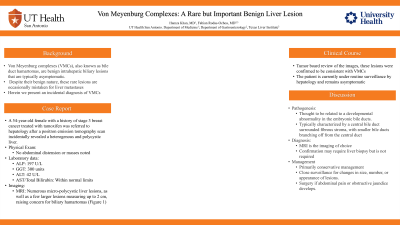Monday Poster Session
Category: Liver
P2458 - Von Meyenburg Complexes: A Rare But Important Benign Liver Lesion
Monday, October 23, 2023
10:30 AM - 4:15 PM PT
Location: Exhibit Hall

Has Audio

Hamza Khan, MD
UT Health San Antonio
San Antonio, TX
Presenting Author(s)
Hamza Khan, MD1, Aliya Sharif, MD1, Benjamin Heriford, DO2, Jonathan Selzman, DO2, Umar Siddiqui, DO3, Dakota Bigham, MD3, Fabian V. Rodas, MD4
1UT Health San Antonio, San Antonio, TX; 2University of Texas Health Science Center at San Antonio, San Antonio, TX; 3University of Texas Health Science Center-San Antonio, San Antonio, TX; 4Texas Liver Institute/UTHSCSA, San Antonio, TX
Introduction: Von Meyenburg complexes (VMCs), also known as bile duct hamartomas, are benign intrahepatic biliary lesions that are typically asymptomatic. Despite their benign nature, these rare lesions are occasionally mistaken for liver metastases, leading to unnecessary diagnostic tests and interventions. Here, we present an incidental diagnosis of VMCs to highlight the characteristic imaging findings as well as briefly discuss diagnosis and management.
Case Description/Methods: A 54-year-old female with a history of stage 3 breast cancer treated with tamoxifen was referred to hepatology after a positron emission tomography scan incidentally revealed a heterogenous and polycystic liver. Laboratory tests showed elevated alkaline phosphatase (ALP, 197 U/L), gamma-glutamyl transferase (GGT, 300 units), and alanine transaminase (ALT, 42 U/L) levels, while aspartate aminotransferase (AST) and total bilirubin (TBILI) were within normal limits. Physical examination was negative for any abdominal distension or masses. Subsequent magnetic resonance imaging (MRI) revealed numerous micro-polycystic liver lesions, as well as a few larger lesions measuring up to 2 cm, raising concern for biliary hamartomas (Figure 1). After a tumor board review of the images, these lesions were confirmed to be consistent with VMCs. The patient is currently under routine surveillance by hepatology and remains asymptomatic.
Discussion: The exact pathogenesis of VMCs is unknown, but it is thought to be related to a developmental abnormality in the embryonic bile ducts. They are typically characterized by a central bile duct surrounded by a fibrous stroma, with smaller bile ducts branching off from the central duct. MRI is the preferred imaging modality for the evaluation of VMCs. Characteristically, numerous small, round, and hyperintense lesions on T2-weighted MRI sequences give the liver a "starry sky appearance." In contrast, liver metastases are usually larger, with irregular borders, and may demonstrate heterogeneous enhancement patterns on contrast-enhanced studies. Confirmation of the diagnosis of VMCs may require liver biopsy, but characteristic imaging findings can help avoid unnecessary invasive procedures and interventions. The management of VMCs is primarily conservative, as these lesions are benign and usually asymptomatic. However, close surveillance is recommended to monitor for any changes in size, number, or appearance of lesions.
Disclosures:
Hamza Khan, MD1, Aliya Sharif, MD1, Benjamin Heriford, DO2, Jonathan Selzman, DO2, Umar Siddiqui, DO3, Dakota Bigham, MD3, Fabian V. Rodas, MD4. P2458 - Von Meyenburg Complexes: A Rare But Important Benign Liver Lesion, ACG 2023 Annual Scientific Meeting Abstracts. Vancouver, BC, Canada: American College of Gastroenterology.
1UT Health San Antonio, San Antonio, TX; 2University of Texas Health Science Center at San Antonio, San Antonio, TX; 3University of Texas Health Science Center-San Antonio, San Antonio, TX; 4Texas Liver Institute/UTHSCSA, San Antonio, TX
Introduction: Von Meyenburg complexes (VMCs), also known as bile duct hamartomas, are benign intrahepatic biliary lesions that are typically asymptomatic. Despite their benign nature, these rare lesions are occasionally mistaken for liver metastases, leading to unnecessary diagnostic tests and interventions. Here, we present an incidental diagnosis of VMCs to highlight the characteristic imaging findings as well as briefly discuss diagnosis and management.
Case Description/Methods: A 54-year-old female with a history of stage 3 breast cancer treated with tamoxifen was referred to hepatology after a positron emission tomography scan incidentally revealed a heterogenous and polycystic liver. Laboratory tests showed elevated alkaline phosphatase (ALP, 197 U/L), gamma-glutamyl transferase (GGT, 300 units), and alanine transaminase (ALT, 42 U/L) levels, while aspartate aminotransferase (AST) and total bilirubin (TBILI) were within normal limits. Physical examination was negative for any abdominal distension or masses. Subsequent magnetic resonance imaging (MRI) revealed numerous micro-polycystic liver lesions, as well as a few larger lesions measuring up to 2 cm, raising concern for biliary hamartomas (Figure 1). After a tumor board review of the images, these lesions were confirmed to be consistent with VMCs. The patient is currently under routine surveillance by hepatology and remains asymptomatic.
Discussion: The exact pathogenesis of VMCs is unknown, but it is thought to be related to a developmental abnormality in the embryonic bile ducts. They are typically characterized by a central bile duct surrounded by a fibrous stroma, with smaller bile ducts branching off from the central duct. MRI is the preferred imaging modality for the evaluation of VMCs. Characteristically, numerous small, round, and hyperintense lesions on T2-weighted MRI sequences give the liver a "starry sky appearance." In contrast, liver metastases are usually larger, with irregular borders, and may demonstrate heterogeneous enhancement patterns on contrast-enhanced studies. Confirmation of the diagnosis of VMCs may require liver biopsy, but characteristic imaging findings can help avoid unnecessary invasive procedures and interventions. The management of VMCs is primarily conservative, as these lesions are benign and usually asymptomatic. However, close surveillance is recommended to monitor for any changes in size, number, or appearance of lesions.
Disclosures:
Hamza Khan indicated no relevant financial relationships.
Aliya Sharif indicated no relevant financial relationships.
Benjamin Heriford indicated no relevant financial relationships.
Jonathan Selzman indicated no relevant financial relationships.
Umar Siddiqui indicated no relevant financial relationships.
Dakota Bigham indicated no relevant financial relationships.
Fabian Rodas indicated no relevant financial relationships.
Hamza Khan, MD1, Aliya Sharif, MD1, Benjamin Heriford, DO2, Jonathan Selzman, DO2, Umar Siddiqui, DO3, Dakota Bigham, MD3, Fabian V. Rodas, MD4. P2458 - Von Meyenburg Complexes: A Rare But Important Benign Liver Lesion, ACG 2023 Annual Scientific Meeting Abstracts. Vancouver, BC, Canada: American College of Gastroenterology.
